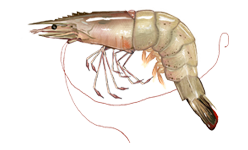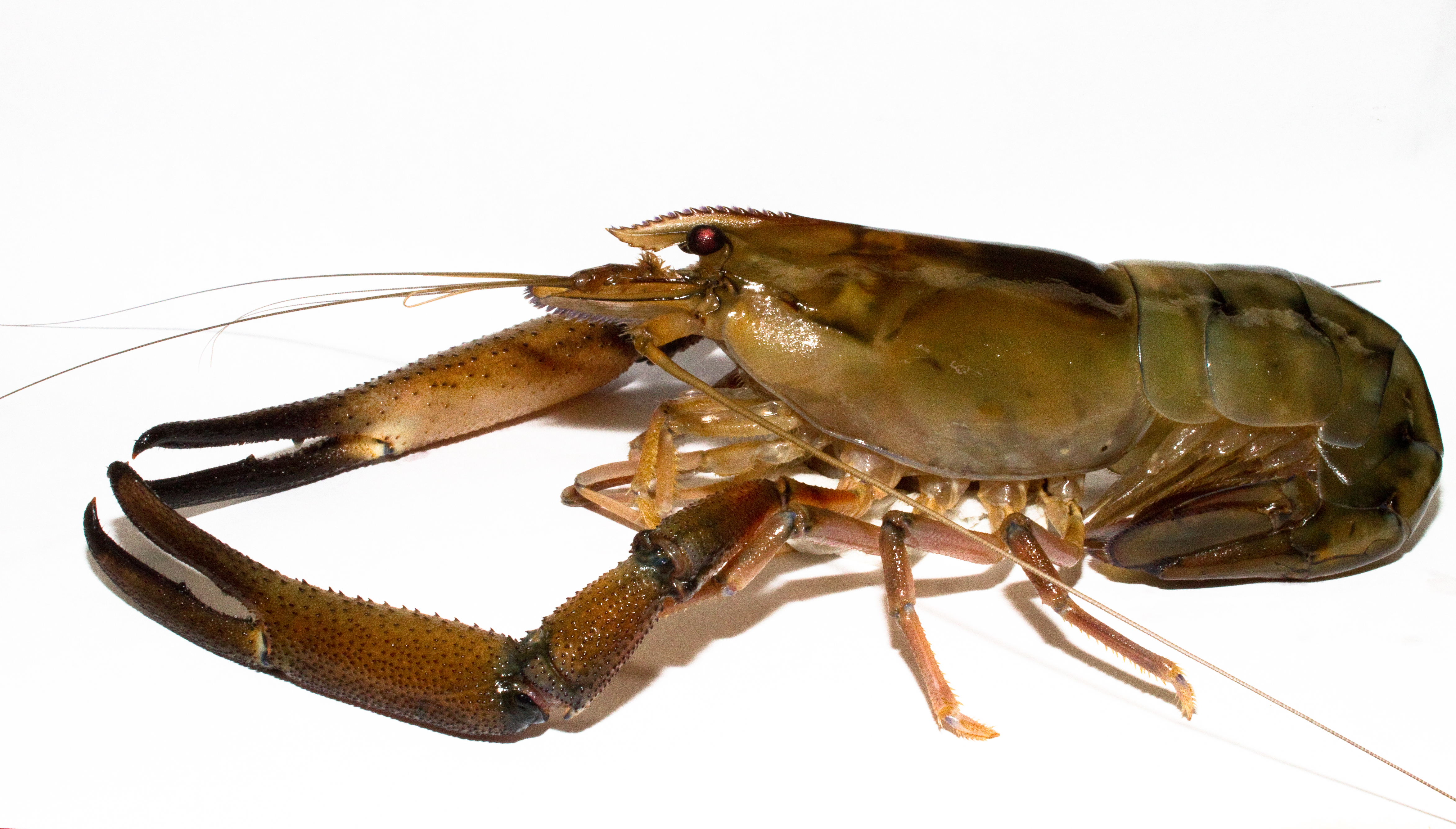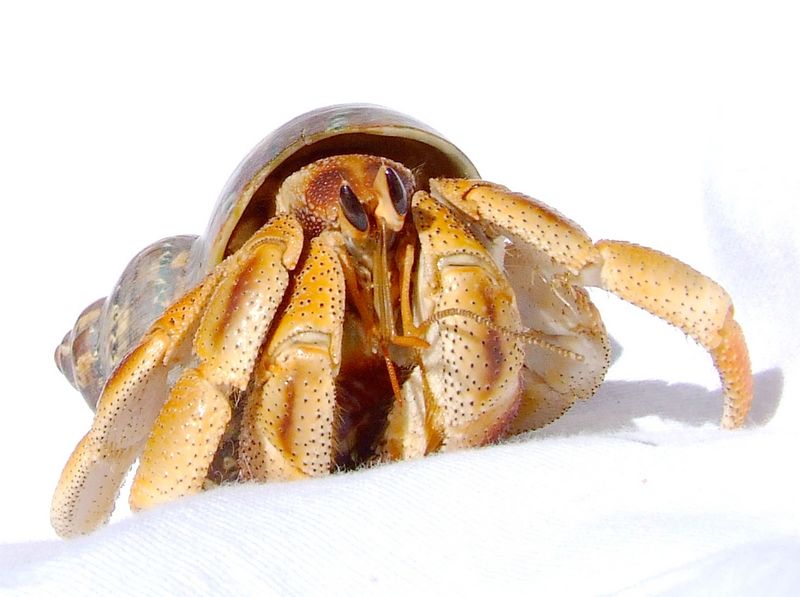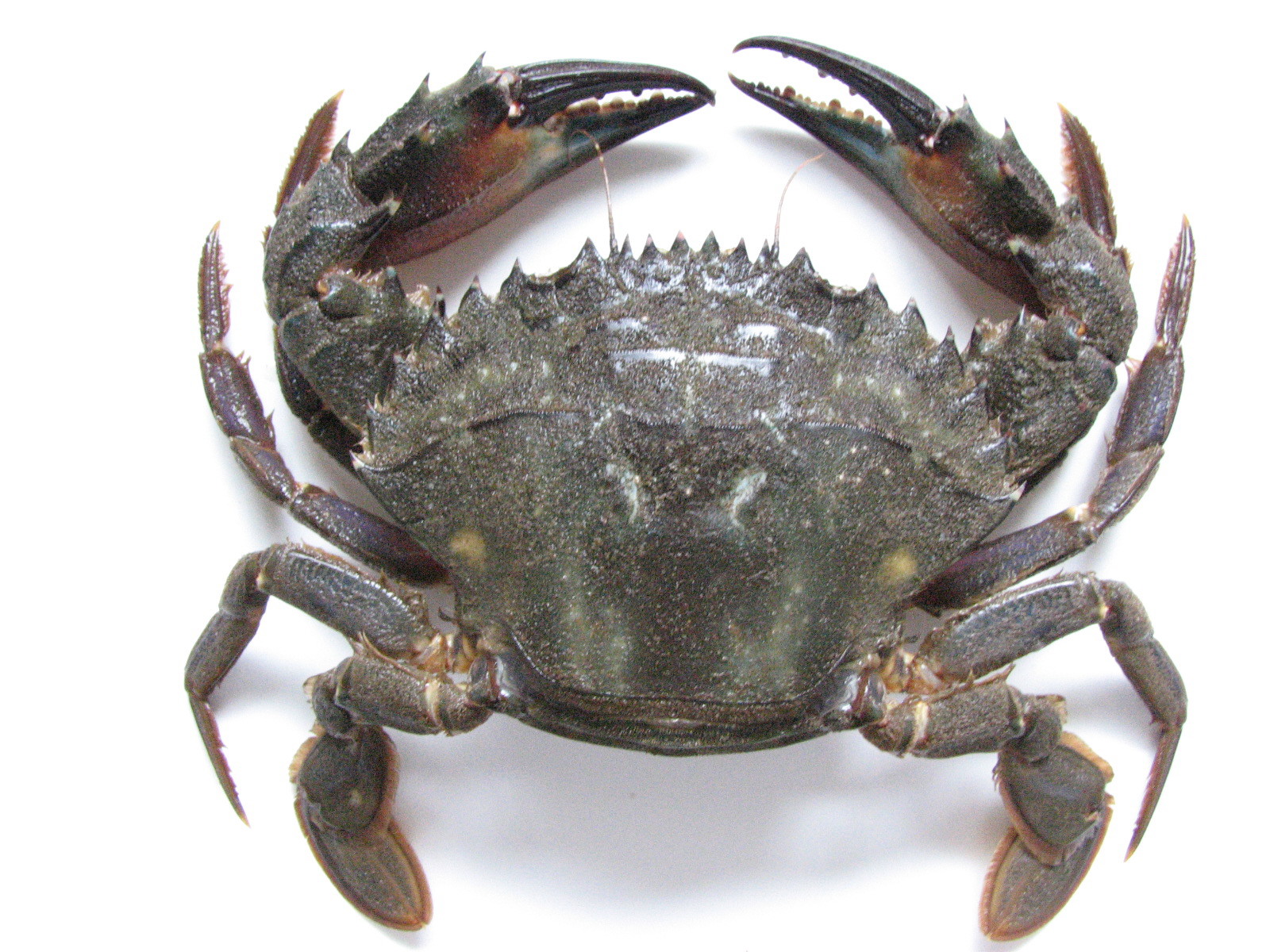|
Pleocyemata
Pleocyemata is a suborder of decapod crustaceans, erected by Martin Burkenroad in 1963. Burkenroad's classification replaced the earlier sub-orders of Natantia and Reptantia with the monophyletic groups Dendrobranchiata (prawns) and Pleocyemata. Pleocyemata contains all the members of the Reptantia (including crabs, lobsters, crayfish, and others), as well as the Stenopodidea (which contains the so-called "boxer shrimp" or "barber-pole shrimp"), and Caridea, which contains the true shrimp. Anatomy All members of the Pleocyemata are united by a number of features, the most important of which is that the fertilised eggs are incubated by the female, and remain stuck to the pleopods (swimming legs) until the zoea larvae are ready to hatch. It is this characteristic that gives the group its name. Pleocyemata also possess a lamellar gill structure as opposed to the branches found in the Dendrobranchiata. Systematics The cladogram below shows Pleocyemata as the sister clade to Den ... [...More Info...] [...Related Items...] OR: [Wikipedia] [Google] [Baidu] |
Decapoda
The Decapoda or decapods (literally "ten-footed") are an order of crustaceans within the class Malacostraca, including many familiar groups, such as crabs, lobsters, crayfish, shrimp and prawns. Most decapods are scavengers. The order is estimated to contain nearly 15,000 species in around 2,700 genera, with around 3,300 fossil species. Nearly half of these species are crabs, with the shrimp (about 3,000 species) and Anomura including hermit crabs, porcelain crabs, squat lobsters (about 2500 species) making up the bulk of the remainder. The earliest fossil decapod is the Devonian '' Palaeopalaemon''. Anatomy Decapods can have as many as 38 appendages, arranged in one pair per body segment. As the name Decapoda (from the Greek , ', "ten", and , '' -pod'', "foot") implies, ten of these appendages are considered legs. They are the pereiopods, found on the last five thoracic segments. In many decapods, one pair of these "legs" has enlarged pincers, called chelae, with the l ... [...More Info...] [...Related Items...] OR: [Wikipedia] [Google] [Baidu] |
Reptantia
Reptantia is a clade of decapod crustaceans named in 1880 which includes lobsters, crabs and many other well-known crustaceans. Classification In older classifications, Reptantia was one of the two sub-orders of Decapoda alongside Natantia, with Reptantia containing the walking forms, and Natantia containing the swimming forms (prawns, shrimp and boxer shrimp). However, in 1963 Martin Burkenroad found Natantia to be paraphyletic and invalid, and instead split Decapoda into the two sub-orders of Dendrobranchiata (prawns) and Pleocyemata. Pleocyemata contains all the members of the Reptantia (including crabs, lobsters, crayfish, and others), as well as the Stenopodidea ("boxer shrimp"), and Caridea (true shrimp). Reptantia remains a valid monophyletic grouping, but is now no longer ranked as a sub-order. Anatomy The name Reptantia means "those that walk", and contains those decapods whose primary mode of locomotion is to walk along a surface using the pereiopods rather th ... [...More Info...] [...Related Items...] OR: [Wikipedia] [Google] [Baidu] |
Dendrobranchiata
Dendrobranchiata is a suborder of decapods, commonly known as prawns. There are 540 extant species in seven families, and a fossil record extending back to the Devonian. They differ from related animals, such as Caridea and Stenopodidea, by the branching form of the gills and by the fact that they do not brood their eggs, but release them directly into the water. They may reach a length of over and a mass of , and are widely fished and farmed for human consumption. Shrimp and prawns While Dendrobranchiata and Caridea belong to different suborders of Decapoda, they are very similar in appearance, and in many contexts such as commercial farming and fisheries, they are both often referred to as "shrimp" and "prawn" interchangeably. In the United Kingdom, the word "prawn" is more common on menus than "shrimp", while the opposite is the case in North America. The term "prawn" is also loosely used to describe any large shrimp, especially those that come 15 (or fewer) to the pound (su ... [...More Info...] [...Related Items...] OR: [Wikipedia] [Google] [Baidu] |
Natantia
Natantia (Boas, 1880) is an obsolete taxon of decapod crustaceans, comprising those families that move predominantly by swimming – the shrimp (comprising Caridea and Procarididea), prawns (Dendrobranchiata) and boxer shrimp. The remaining Decapoda were placed in the Reptantia, and consisted of crabs, lobsters and other large animals that move chiefly by walking along the bottom. The division between Natantia and Reptantia was replaced in 1963, when Martin Burkenroad erected the suborder Pleocyemata for those animals that brood their eggs on the pleopods, leaving Dendrobranchiata for the prawns. Under this system, Natantia is a paraphyletic group In taxonomy, a group is paraphyletic if it consists of the group's last common ancestor and most of its descendants, excluding a few monophyletic subgroups. The group is said to be paraphyletic ''with respect to'' the excluded subgroups. In co .... Burkenroad's primary division of Decapoda into Dendrobranchiata and Pleocyemata ha ... [...More Info...] [...Related Items...] OR: [Wikipedia] [Google] [Baidu] |
Astacidea
Astacidea is an infraorder of decapod crustaceans including lobsters (though not "lobsters" such as the spiny lobster etc.), crayfish, and their close relatives. Description The Astacidea are distinguished from most other decapods by the presence of chelae (claws) on each of the first three pairs of pereiopods (walking legs), the first of which is much larger than the remaining two pairs. The last two pairs of pereiopods are simple (without claws), except in ''Thaumastocheles'', where the fifth pereiopod may have "a minute pincer". Distribution Members of the infraorder Astacidea are found throughout the world – both in the oceans and in fresh water – except for mainland Africa and parts of Asia. Classification Astacidea belongs to the group Reptantia, which consists of the walking/crawling decapods (lobsters and crabs). Astacidea is the sister clade to the infraorder Polychelida, a small group of crustaceans restricted to deep waters. The cladogram below shows Astacidea ... [...More Info...] [...Related Items...] OR: [Wikipedia] [Google] [Baidu] |
Martin Burkenroad
Martin David Burkenroad (March 20, 1910 – January 12, 1986) was an American marine biologist. He specialized in decapod crustaceans and fisheries science. Biography Burkenroad was born in New Orleans in 1910 as the only child of coffee importer David Burkenroad and his artist wife Flora Salinger. His family contained many eccentrics, and Martin was similarly labeled "headstrong". He entered Tulane University in 1926, but although he published his first papers during that time, his studies ended when he was "'encouraged' to leave" in 1929. He then began working for the Carnegie Marine Biological Laboratory in the Dry Tortugas, before joining the Louisiana Department of Conservation in 1931, where he studied the local shrimp fishery. After brief spells at several museums, he joined Yale University under the guidance of A. E. Parr. Burkenroad spent many productive years at Yale, where the usual time limit for research for a dissertation was permanently waived for him, but he n ... [...More Info...] [...Related Items...] OR: [Wikipedia] [Google] [Baidu] |
Stenopodidea
The Stenopodidea or boxer shrimps are a small group of decapod crustaceans. Often confused with Caridea shrimp or Dendrobranchiata prawns, they are neither, belonging to their own group. Anatomy They can be differentiated from the Dendrobranchiata prawns by their lack of branching gills, and by the fact that they brood their eggs instead of directly releasing them into the water. They differ from the Caridea shrimp by their greatly enlarged third pair of legs. Taxonomy Stenopodidea belongs to the order Decapoda, and is most closely related to the Caridea and Procarididea infraorders of shrimp. The cladogram below shows Stenopodidea's relationships to other relatives within Decapoda, from analysis by Wolfe ''et al.'', 2019. There are 71 extant species currently recognized within Stenopodidea, divided into 12 genera. Three fossil species are also recognized, each belonging to a separate genus. The earliest fossil assigned to the Stenopodidea is '' Devonostenopus pennsylvan ... [...More Info...] [...Related Items...] OR: [Wikipedia] [Google] [Baidu] |
Caridea
The Caridea, commonly known as caridean shrimp or true shrimp, are an infraorder of shrimp within the order Decapoda. This infraorder contains all species of true shrimp. They are found widely around the world in both fresh and salt water. Many other animals with similar names – such as the mud shrimp of Axiidea and the boxer shrimp of Stenopodidea – are not true shrimp, but many have evolved features similar to true shrimp. Biology Carideans are found in every kind of aquatic habitat, with the majority of species being marine. Around a quarter of the described species are found in fresh water, however, including almost all the members of the species-rich family Atyidae and the Palaemonidae subfamily Palaemoninae. They include several commercially important species, such as '' Macrobrachium rosenbergii'', and are found on every continent except Antarctica. The marine species are found at depths to , and from the tropics to the polar regions. In addition to the great vari ... [...More Info...] [...Related Items...] OR: [Wikipedia] [Google] [Baidu] |
Procarididea
Procarididea is an infraorder of decapods, comprising only eleven species. Six of these are in the genera '' Procaris'' and '' Vetericaris'', which together make up the family Procarididae. The remaining five species are only known from fossils and belong to the genus '' Udora'', which cannot yet be assigned to any family. The cladogram below shows Procarididea's relationships to other relatives within Decapoda The Decapoda or decapods (literally "ten-footed") are an order of crustaceans within the class Malacostraca, including many familiar groups, such as crabs, lobsters, crayfish, shrimp and prawns. Most decapods are scavengers. The order is esti ..., from analysis by Wolfe ''et al.'', 2019. References Decapods Arthropod infraorders {{Decapoda-stub ... [...More Info...] [...Related Items...] OR: [Wikipedia] [Google] [Baidu] |
Achelata
The Achelata is an infra-order of the decapod crustaceans, holding the spiny lobsters, slipper lobsters and their fossil relatives. Description The name "Achelata" derives from the fact that all the members of this group lack the chelae (claws) that are found on almost all other decapods (from the Ancient Greek , = "not", , = "claw"). They are further united by the great enlargement of the second antennae, by the special " phyllosoma" form of the larva, and by a number of other characters. Classification and fossil record The infraorder Achelata belongs to the group Reptantia, which consists of the walking/crawling decapods (lobsters and crabs). The cladogram below shows Achelata's placement within the larger order Decapoda, from analysis by Wolfe ''et al.'', 2019. Achelata contains the spiny lobsters (Palinuridae), the slipper lobsters (Scyllaridae) and the furry lobsters (Synaxidae, now usually included in Palinuridae), as well as two extinct families, Cancrinidae ... [...More Info...] [...Related Items...] OR: [Wikipedia] [Google] [Baidu] |
Polychelida
Polychelida is an infraorder of decapod crustaceans. Fossil representatives are known dating from as far back as the Upper Triassic. A total of 38 extant species, all in the family Polychelidae, and 55 fossil species have been described. History Polychelida had traditionally been included in the infraorder Palinura, alongside the spiny lobsters and slipper lobsters (now in the infraorder Achelata). In 1995, Gerhard Scholtz and Stefan Richter of the carried out a phylogenetic study of the "Reptantia", and concluded that "Palinura" was paraphyletic. They therefore abandoned that taxon and introduced instead the new clade Polychelida. Classification Polychelida belongs to the group Reptantia, which consists of the walking/crawling decapods (lobsters and crabs). Polychelida is the sister clade to the infraorder Astacidea, which contains the "true" lobsters and crayfish. The cladogram below shows Polychelida's placement within the larger order Decapoda, from analysis by Wolfe ... [...More Info...] [...Related Items...] OR: [Wikipedia] [Google] [Baidu] |
Axiidea
Axiidea is an infraorder of decapod crustaceans. They are colloquially known as mud shrimp, ghost shrimp, or burrowing shrimp; however, these decapods are only distantly related to true shrimp. Axiidea and Gebiidea are divergent infraoders of the former infraorder Thalassinidea. These infraorders have converged ecologically and morphologically as burrowing forms.Dworschak, Peter C. (2012). ''Treatise on Zoology - Anatomy, Taxonomy, Biology. The Crustacea, Volume 9 Part B''. BRILL. pp. 109–100. . Based on molecular evidence as of 2009, it is now widely believed that these two infraorders represent two distinct lineages separate from one another. Since this is a recent change, much of the literature and research surrounding these infraorders still refers to the Axiidea and Gebiidea in combination as "thalassinidean" for the sake of clarity and reference. This division based on molecular evidence is consistent with the groupings proposed by Robert Gurney in 1938 based on larval ... [...More Info...] [...Related Items...] OR: [Wikipedia] [Google] [Baidu] |










